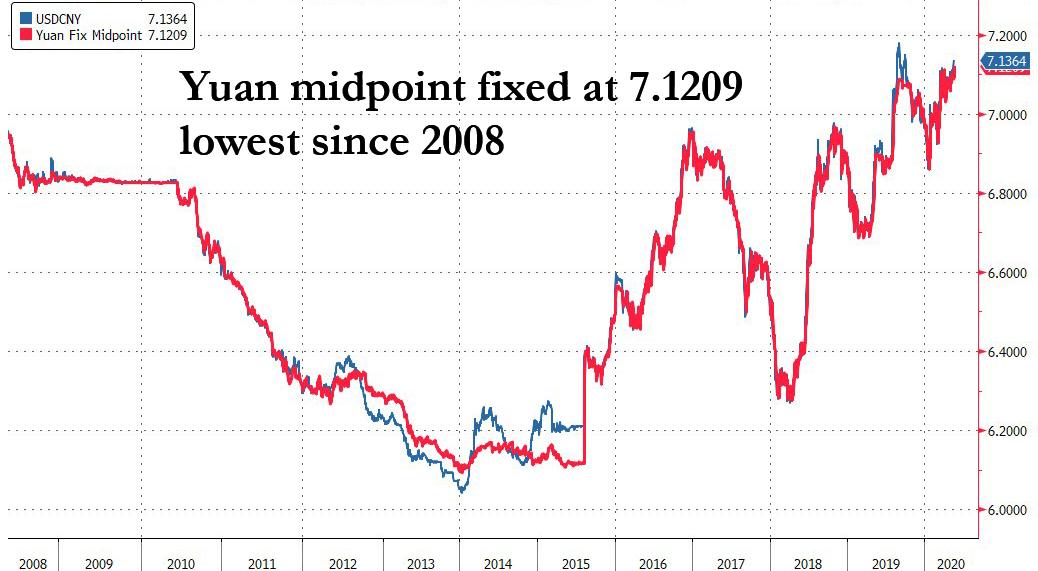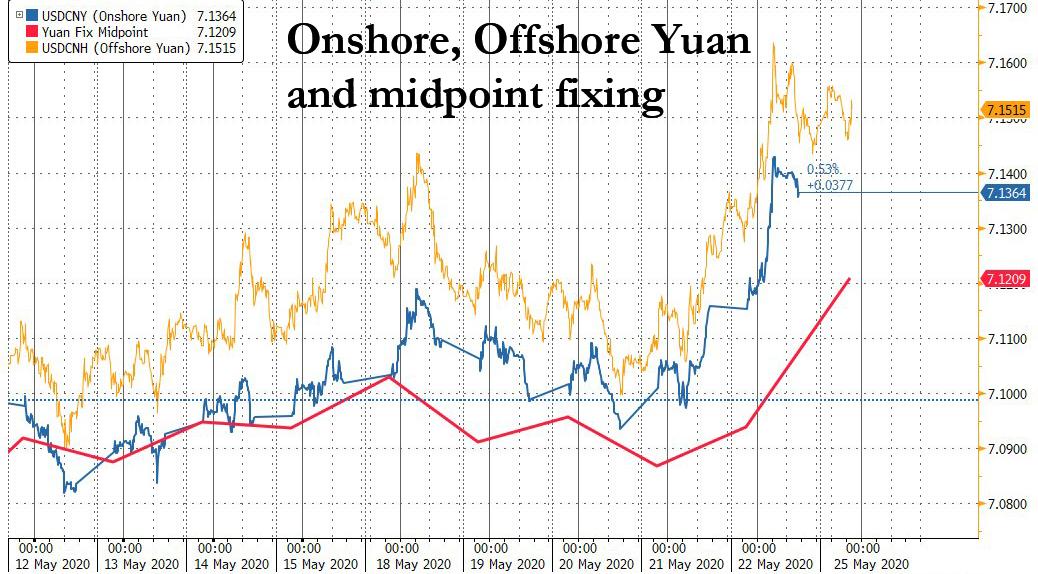China Sets Yuan Fix At Weakest Since 2008
Tyler Durden
Sun, 05/24/2020 – 22:32
Just hours after China’s Foreign Minister Wang Yi warned that “some” in America were pushing relations to a “new Cold War”, Beijing made it clear how it intends to retaliate in this new paradigm: by doing the one thing that infuriates Trump more than anything, devaluing its currency.
After the PBOC fixed the yuan at 7.0939 on Friday, the PBOC set the Monday USDCNY midpoint at 7.1209, which was not only weaker than the expected fix of 7.1205 but the weakest fixing since 2008.
Zooming in on the past 10 days shows the sharp bounce in the past three days in both the fixing, the onshore and the offshore yuan, the last of which is now just shy of the lows hit during the March crash, if still below the all time lows hit on Sept 2, 2019 when the USDCNH spiked as high as 7.1940 in response to the escalating trade war.
That said, some – such as Bloomberg – had a different expectation for the fixing, which they saw as 7.1220, which would in turn mean a stronger than expected fixing, and one suggesting that the PBOC has activated its countercyclical buffer to slow the drop of the onshore yuan as the offshore yuan slumps. Their conclusion, which is counter to sellside expectations, is that this marks a shift in the PBOC’s countercyclical adjustments and “could be seen as a warning shot toward speculators betting on a weaker yuan.”
Whether Bloomberg’s fixing model is correct, or consensus expectations for a stronger fix are right, remains to be seen however if indeed it is China’s stance to devalue the yuan in response to the sharp deterioration in Sino-US relations then expect the offshore yuan to take the lead and to keep sliding, giving the PBOC cover for further devaluation and telegraphing how it plans on responding to the “cold war” and any future escalations by the US.
Ironically, the very same Bloomberg, in a different report, notes that “the spread between spot USD/CNH and USD/CNY is likely to become more volatile in coming days, driven by a widening bias. A combination of U.S.-China political tension and unrest in Hong Kong will provide a negative feedback loop into the offshore yuan.”
The PBOC can be expected to maintain a tight grip on the daily yuan fixing and enforce the 2% fluctuation range. But there is no such constraint for the offshore yuan, which is free to roam, only being pulled back into line by FX arbitrageurs or in response to speculation about central bank intervention.
As author Mark Crankfield writes, “the CNH forwards curve can also be expected to see an upward trajectory. The spread spiked to more than 10 big figures several times during previous periods of yuan turbulence. A similar outcome is likely in the near term, as investors consider what the threat of a new cold war will mean for risk assets.“
One thing to note: the last time the offshore yuan was here, the S&P was at 2,300.
Finally, here is a reminder from Rabobank’s Michael Every why in the current environment of escalating hostility between the US and China, the only thing that matters is the Yuan, and why in the not too distant future, the Chinese currency may have a 10-handle in front of it.
This time last year, when we were all still going abroad regularly (right now just ‘outside’ is becoming a psychological barrier if I am honest) I was traveling with a presentation titled “Clause is Cause”. This argued that from a geostrategic ‘Von Clausewitz’ perspective, not a neoliberal “Let’s assume world peace” version, the US would at some point realise the USD/Eurodollar was a weapon it could wield vs. China, and when it did we would see three key strings cut: trade; tech; and then capital flows. The first was evident during the trade war – which has not been concluded is likely to get far worse soon; the second is also abundantly clear on a variety of fronts, much to Silicon Valley’s chagrin; and potentially, now we see the start of that third step – because if the US does block this first USD50bn going in, other such steps will follow, just as they did on the previously unthinkable idea of US tariffs on China.
CNH is right to be selling off, albeit in a traditionally limited fashion, because if you don’t buy from China and you don’t help China up the value-chain and you don’t invest in China then China is not going to be getting much USD liquidity at all. The US hawks probably don’t get the Eurodollar iron logic there; they are likely just pressing buttons in anger. The outcome would be the same nonetheless.
I can hear the market bulls and technocrats of the world saying “But China has USD3 trillion in reserves!” Perhaps. Most think it’s far lower than that. And not earning USD means you have to dig into that stockpile. And when you do, the PBOC either has to contract the local money supply (because every USD is backed by 7.xx CNY on the other side of the balance sheet) or it just creates new CNY anyway and supply-demand sees CNY move sharply lower – as we have been seeing in all other EM FX. Looking at the drop in BRL, ARS, ZAR, TRY, etc., or even THB, this would be how we would get to the ‘unthinkable’ 8 (9? 10?) handle in CNY. That would also crush those other EM crosses in tandem – and AUD and NZD, as the former tries to navigate its own geopolitical spat with Beijing.
And so with the Fed having taken over most US capital markets which have now lost most if not all of their discounting and signaling capabilities, keep an eye on that USDCNH: ironically, it may be the last true market stress indicator left.


